
PUO
Dr. Hasanain
“ Pyrexia of Unknown
Origin ”
Total Lec: 29


Fever without a focus
(Pediatric Mystery)
LEARNING OBJECTIVES
1- Define fever and FUO.
2- Put a differential diagnosis.
3- Master a panel of investigations.
4- Decide when to start empirical therapy?
MCQ
The commonest cause of PUO is:
A- A common disease presenting in an atypical way.
B- A rare disease presenting in atypical way.
C- A common disease presenting typically.
D- A rare disease presenting typically.
ANSWER A
•
A 10 - year old female, presented to the outpatient clinic with a 4 - week
history of fever (38.3 C – 39.5 C) and easy fatigability. She underwent a good
primary work up by the family physician prior to referral with failure to reach a
diagnosis. She is sitting now with her worried parents in the desk next to you
and ready to receive your questions and actions.
1- How you define this complaint in view of duration?
2- Put a differential diagnosis inside a general frame?
3- What shall you ask in the context of history?
4- What are the general and special sites you look for in physical
examination?
5- Set a panel of investigations you are planning to perform?
6- Start a treatment plan?
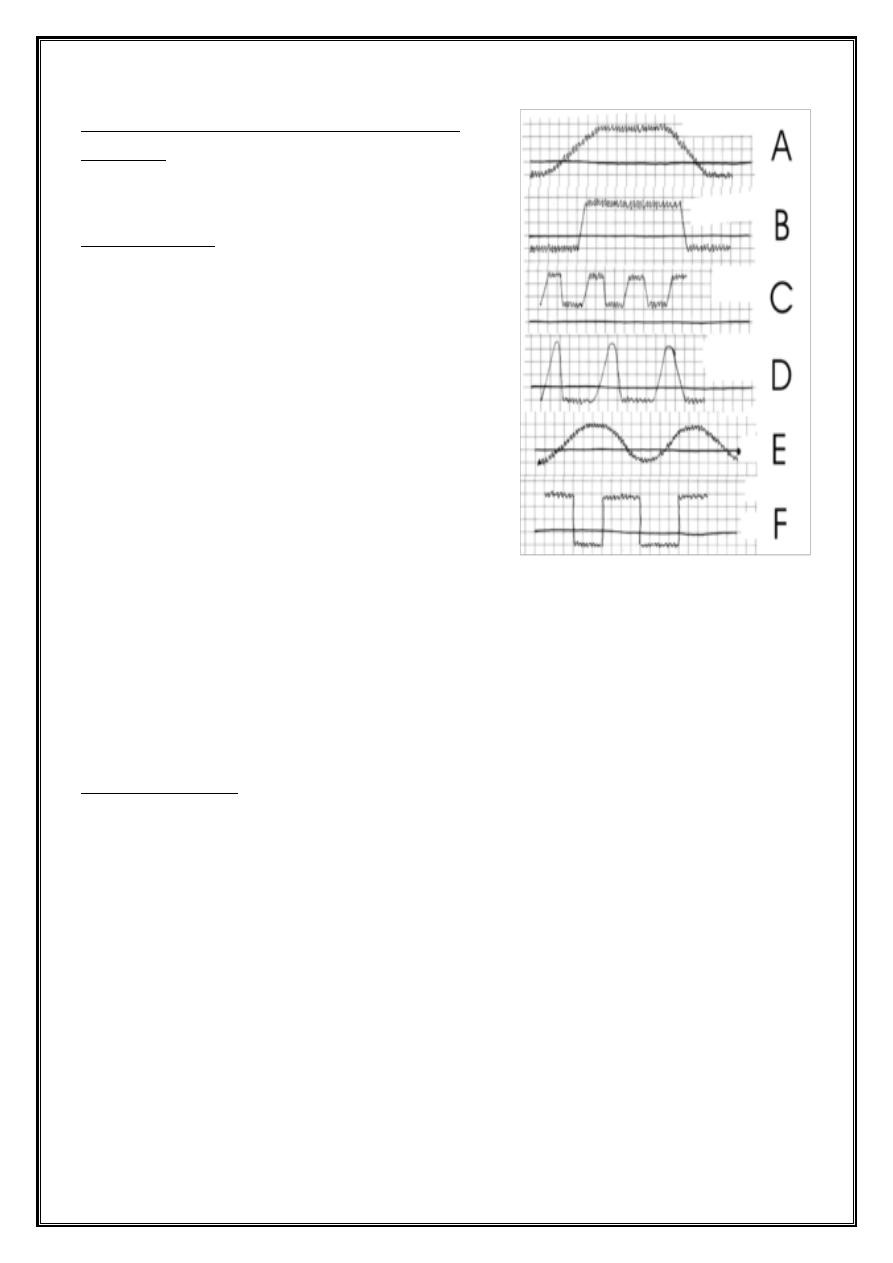
1- How you define this complaint in view of
duration?
DEFINITIONS
• Fever: A rectal temperature of ≥38 C. It
fluctuates in degree and timing.
• FWLS (Fever without localising sign): Fever
of acute onset, with duration of <1 wk and
without localizing signs.
• FUO (Fever of unknown origin): Fever
documented by a health care provider and
for which the cause could not be identified
after 3 wk of evaluation as an outpatient
or after 1 wk of evaluation in the hospital.
• Range of normal temperature
o Axillary 36 - 37.4
°
C
o Oral 36.7 - 37.7
°
C
o Rectal 36.9 - 37.9
°
C
PATHOGENESIS
Regulators:
1. Thermo sensitive neurons in pre-optic and anterior hypothalamus
2. Blood temperature
3. Receptors in skin and muscles
Mechanisms:
1- Pyrogens (endogenous and exogenous)
2- Heat production exceeding loss
3- Defective Heat loss
A. B. Continuous: Temperature remains above normal throughout the day and does
not fluctuate more than 1 °C in 24 hrs.Typhoid, lobar pneumonia,
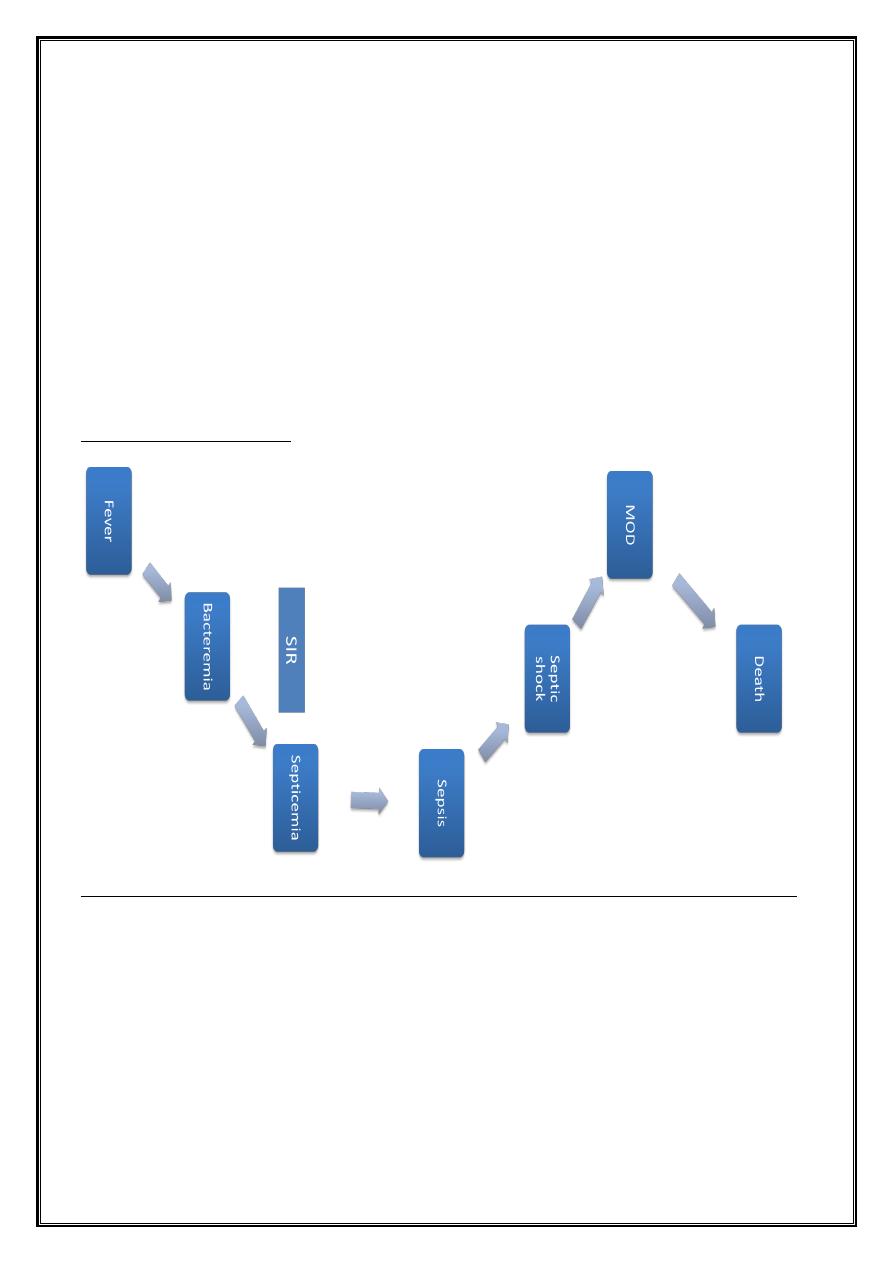
C- Remittent: Temperature remains above normal throughout the day and fluctuates
more than 1 °C in 24 hours. SBE
D. Intermittent: The temperature elevation is present only for a certain period, later
cycling back to normal. Kala Azar
E. Undulant: fever is typically undulant, rising and falling like a wave Brucellosis
F. Relapsing: multiple episodes of fever occur and each may last up to 3 days.
Individuals may be free of fever for up to 2 weeks before it returns. Tick borne
Remember the sequelae
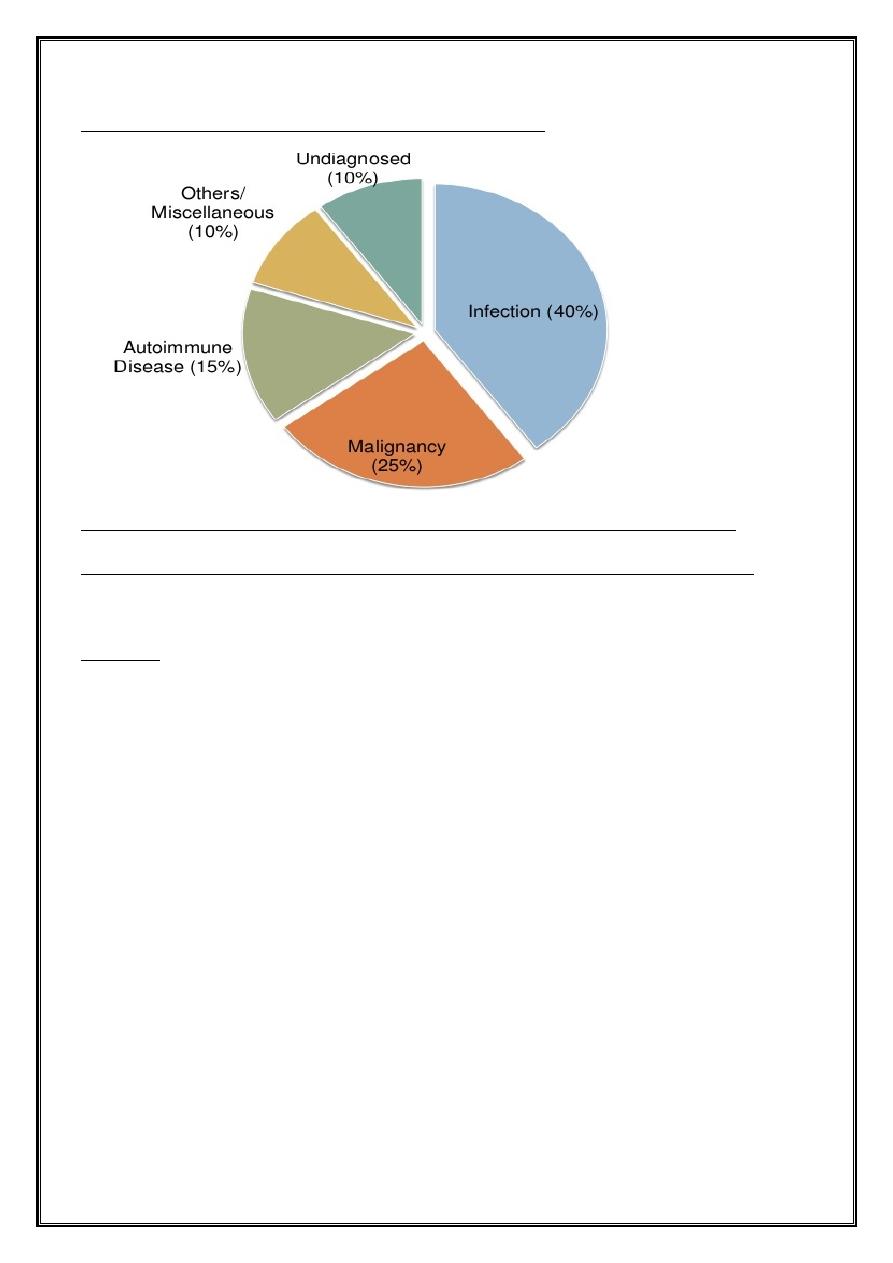
2- Put a differential diagnosis inside a general frame?
between 5 and 15% of FUO cases defy diagnosis, despite exhaustive studies.
CAUSES
1- Infections:
• Bacterial
• Systemic: Brucellosis, Salmonella, Tuberculosis
• Localized infections: Osteomyelitis, Pneumonia and Sinusitis
• Viruses: CMV, Hepatitis viruses ,HIV, IM (Epstein-Barr virus)
• Parasitic Diseases: Malaria ,Toxoplasmosis
• Fungal diseases
2- Rheumatologic diseases
• JRA, Rheumatic fever, SLE and drug fever.
3- Neoplasms
• Leukemia, Lymphoma, other malignancies.
4- Miscellaneous

• Familial Mediterranean fever, Kawasaki disease.
5- Undiagnosed
Always look for
Abscesses: Abdominal, brain, dental, hepatic, pelvic, perinephric, rectal, subphrenic,
psoas
APPROACH
The Best Approach
“there is no substitute for observing the patient, talking to him and thinking about
him”
3- What shall you ask in the context of history?
HISTORY
Fever specifications, sweating, antipyretics use and response, appearance, other
complaints (CNS, urinary,,,,), pain (severity, site), rash and distribution, arthralgia /
arthritis, travel, contact, animals, medications, hospitalization, immunizations,
ethnicity, exposure to contaminated food or water.
4- What are the general and special sites you look for in physical examination?
CAREFUL PHYSICAL EXAMINATION
General appearance and vital signs (heart rate, pressure, respiratory, temperature),
pallor, jaundice, clubbing, skin and scalp, eyes, sinuses, oropharynx, LN, abdomen,
musculoskeletal, genitourinary.

5- Set a panel of investigations you are planning to perform?
INVESTIGATIONS
Level 1:
CBC differentials, ESR, CRP, metabolic panel (RFT, LFT, elects), GUE, stool, C/S, LP,
CXR, US, TB, EBV, CMV, cultures.
Level 2:
Echo, CT, Bone scan, Serology, Autoimmune, Bone marrow
Level 3:
Tissue biopsy, Endoscopy
•
avoid indiscriminately ordering a large battery of tests.
6- Start a treatment plan?
Treatment
in general, NONE Until diagnosis
You should know that
1. most children will get better
2. most children have common illnesses
3. it hasn’t killed them yet! So do not rush to antibiotic treatment.
Admit
1- Reliability
2- Toxicity
3- Invasive investigations
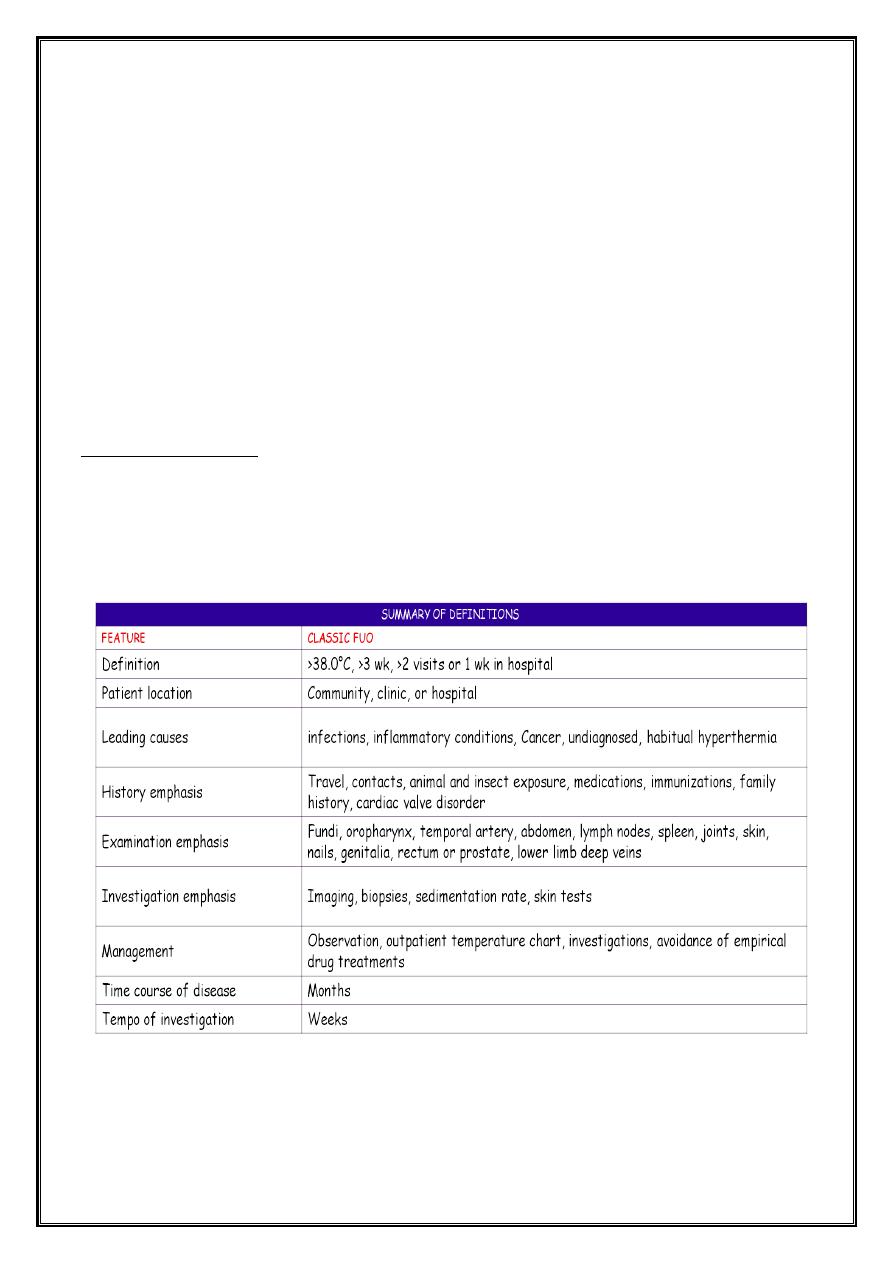
Empirical therapy (little or no role in cases of classic fever of unknown origin) is
indicated only in:
1. Nonsteroidal agents in presumed JIA
2. Antituberculosis drugs in critically ill children with possible disseminated TB
3. Clinically deteriorating with suspicion of bacteremia or sepsis.
4. Immunocompromised
Antibiotics if used should be at targeted disease rather than blanket therapy with 4-5
antibiotics.
Take home message
•
FUO is more likely to be an unusual presentation of a common disorder than a
common presentation of a rare disorder.
•
Giving antibiotics to a child with FUO is like shooting a gun into dark room
Thank you

Fever without a focus
(Pediatric Mystery)
Hints
• As the duration of fever increases, infectious etiology decreases
• Malignancy and factitious fever should be considered with more prolonged
fever
• The most critical features of the evaluation of a patient with FUO is to take a
carefully history and to reassess the patient frequently.
• The Best Approach is “there is no substitute for observing the patient, talking
to him and thinking about him”
• It is important to look for uncommon presentation of common disease and to
perform a detailed physical examination
• Clinically challenging - get expert help! Clinical balance between trial
antimicrobial (often anti tuberculosis regimen) or corticosteroid trial.
• avoid indiscriminately ordering a large battery of tests.
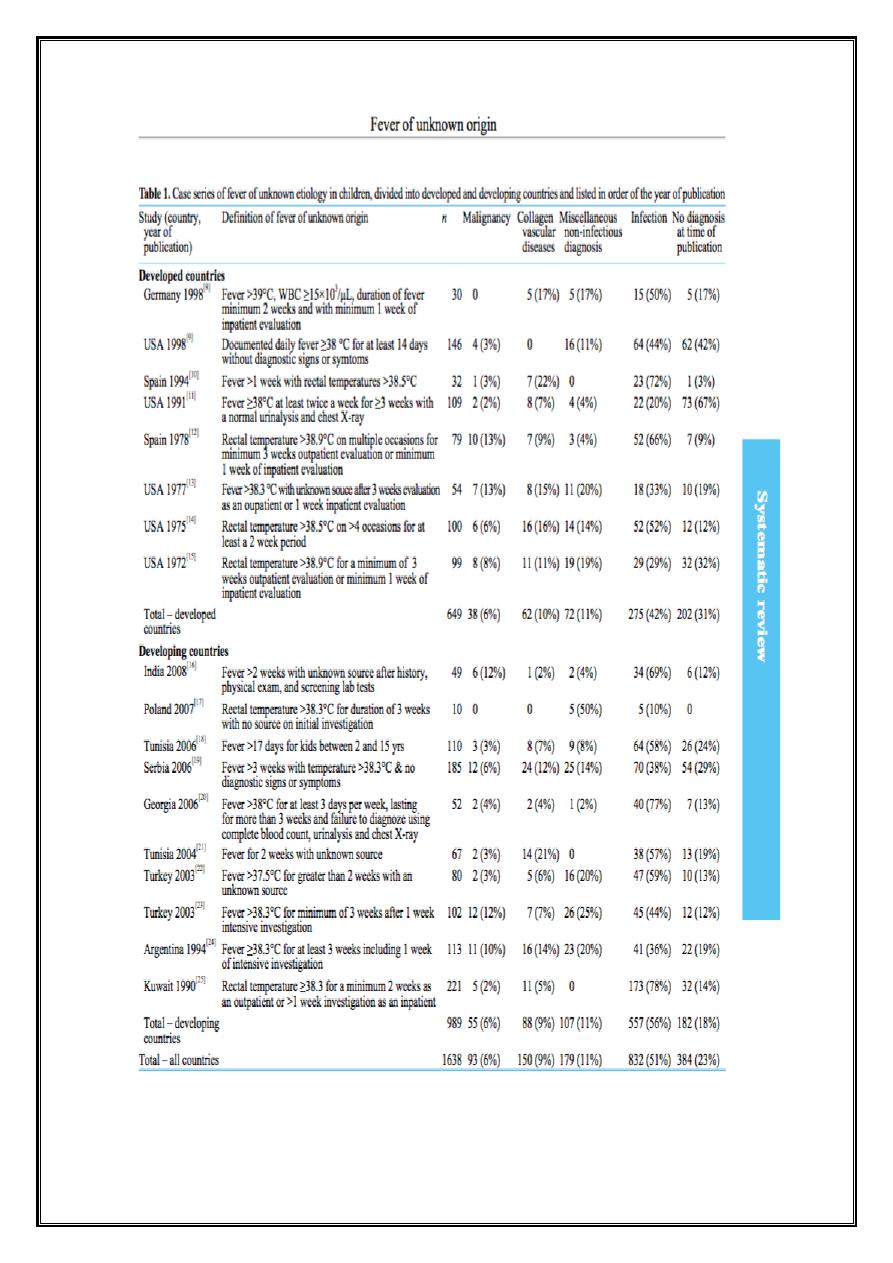
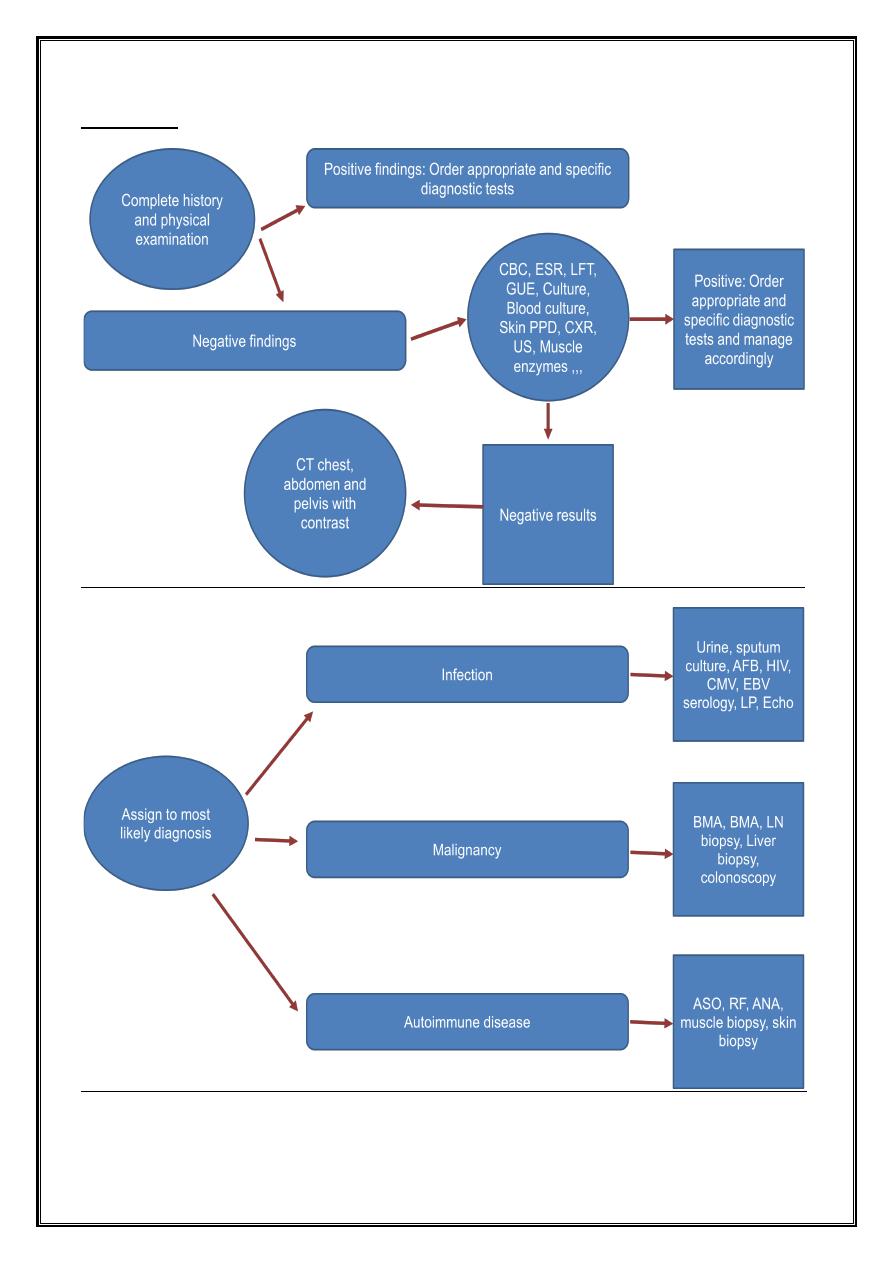
Approach
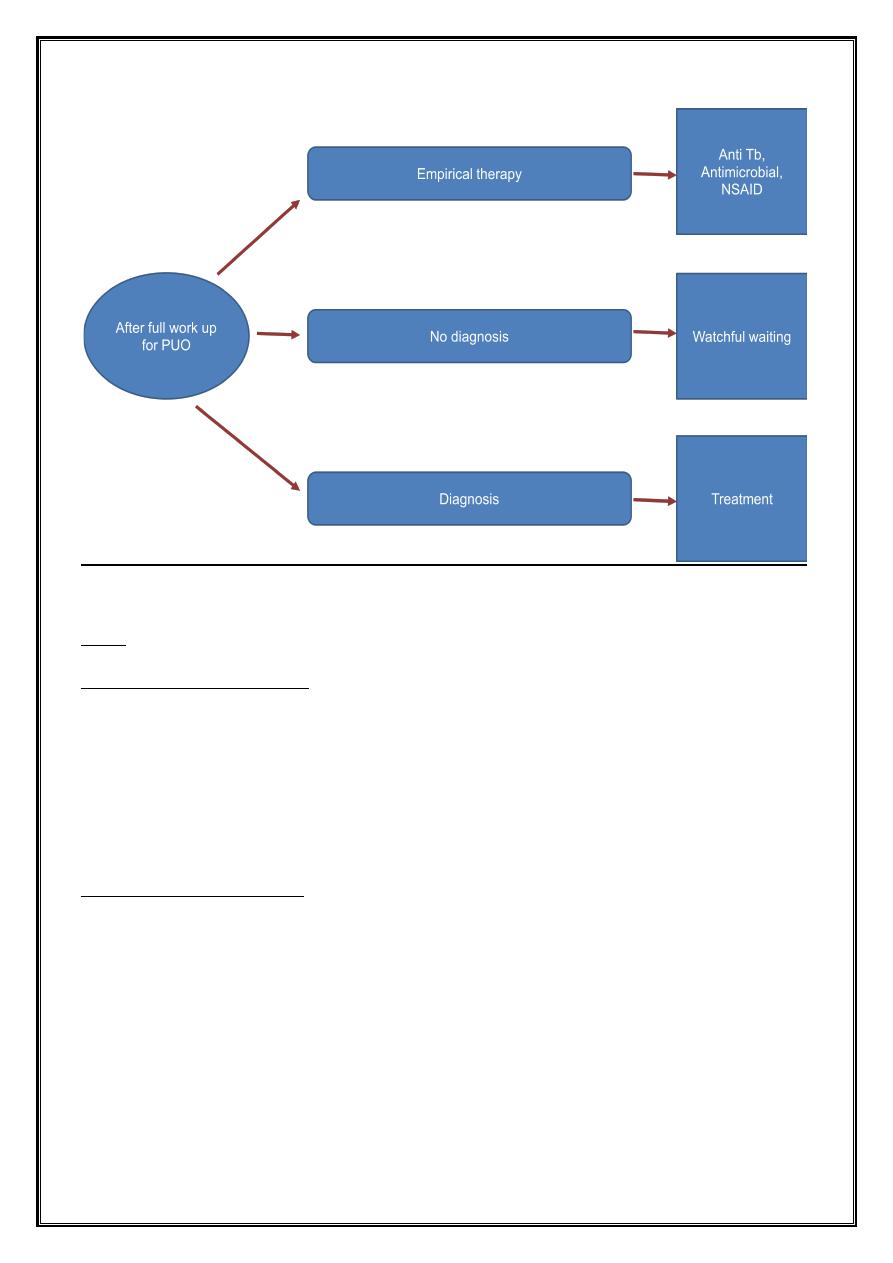
Task
1- Intra abdominal abscess
History: Seven-year old male, PUO, Swinging in nature, with non specific localizing
abdominal pain and a prior history of appendicitis.
Physical examination: Febrile, Right iliac fossa mass
Order relevant investigations and outline treatment accordingly.
2- Pulmonary tuberculosis
History: Eleven-year old male, PUO, cough, Weight loss, father have chronic
undiagnosed cough.
Physical examination: Febrile, cachectic, no LAP, bronchial breathing in the right
upper zone.
Order relevant investigations and outline treatment accordingly.

3- Bacterial endocarditis
History: Three-year old boy, PUO, known case of congenital heart disease
(Ventricular septal defect),
Physical examination: Febrile and heart murmur.
Order relevant investigations and outline treatment accordingly.
4- Urinary tract infection
History: Seven-month old female, recurrent fever and diarrhea, failure to thrive,
repeated episodes of vomiting
Physical examination: Febrile, wasted,
Order relevant investigations and outline treatment accordingly.
5- Osteomyelitis
History: Three-year old female, PUO, limping, tenderness in the right lower thigh.
Physical examination: Febrile, toxic, swelling and tenderness in the lower right thigh.
Order relevant investigations and outline treatment accordingly.
6- Brucellosis
History: Ten-year old girl, PUO, drenching sweating, history of ingestion of diary
product, back pain
Physical examination: Febrile, sweating
Order relevant investigations and outline treatment accordingly.
7- Kala-azar
History: Three-year old female, from Diyala, PUO, abdominal distension, poor
appetite.
Physical examination: Febrile, organomegaly
Order relevant investigations and outline treatment accordingly.

8- Mononucleosis
History: Nine-year old girl, PUO, bilateral cervical swelling, sore throat.
Physical examination: Febrile, cervical LAP, exudative tonsillitis.
Order relevant investigations and outline treatment accordingly.
9- HIV
History: Four-year old girl, recurrent fever, recurrent infections, skin rash
(ecchymoses), mother is on regular blood transfusion
Physical examination: Febrile, pneumonia, organomegaly, wasted
Order relevant investigations and outline treatment accordingly.
10- Leukemia
History: Four-year old girl, PUO, abdominal distension, cervical swelling, skin rash
(ecchymosis)
Physical examination: Febrile, pallor, generalized LAP, petachial rash and
ecchymoses, hepatosplenomegaly.
Order relevant investigations and outline treatment accordingly.
11- Lymphoma
History: Four-year old girl, PUO, weight loss, sweating and abdominal distension
Physical examination: Fever, pallor, abdominal mass
Order relevant investigations and outline treatment accordingly.
12- Juvenile Rheumatoid Arthritis
History: Thirteen-year old girl, PUO, small joints swellings, skin rash.
Physical examination: Febrile, joint swellings, maculopapular skin rash
Order relevant investigations and outline treatment accordingly.

13- Drug fever
History: Four-year old girl, recurrent fever, case of undiagnosed fever on multiple
drugs intake
Physical examination: Febrile,
Order relevant investigations and outline treatment accordingly.
14- Factitious fever
History: Five-year old girl, fever, non plausible manifestations, after a period of
legitimate disorder, mother is a medical staff.
Physical examination: Febrile.
Order relevant investigations and outline treatment accordingly.
15- Toxoplasmosis
History: Seven-year old male, PUO, low grade with painless cervical swelling. History
of raising pets at home.
Physical examination: Febrile, unilateral cervical LAP.
Order relevant investigations and outline treatment accordingly.
Thank you
